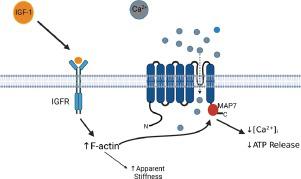Cell Calcium ( IF 4.3 ) Pub Date : 2021-08-31 , DOI: 10.1016/j.ceca.2021.102467 Nicholas Trompeter 1 , Joseph D Gardinier 2 , Victor DeBarros 3 , Mary Boggs 3 , Vimal Gangadharan 3 , William J Cain 3 , Lauren Hurd 3 , Randall L Duncan 4

|
Both mechanical and biochemical stimulation are required for maintaining the integrity of articular cartilage. However, chondrocytes respond differently to mechanical stimuli in osteoarthritic cartilage when biochemical signaling pathways, such as Insulin-like Growth Factor-1 (IGF-1), are altered. The Transient Receptor Potential Vanilloid 4 (TRPV4) channel is central to chondrocyte mechanotransduction and regulation of cartilage homeostasis. Here, we propose that changes in IGF-1 can modulate TRPV4 channel activity. We demonstrate that physiologic levels of IGF-1 suppress hypotonic-induced TRPV4 currents and intracellular calcium flux by increasing apparent cell stiffness that correlates with actin stress fiber formation. Disruption of F-actin following IGF-1 treatment results in the return of the intracellular calcium response to hypotonic swelling. Using point mutations of the TRPV4 channel at the microtubule-associated protein 7 (MAP-7) site shows that regulation of TRPV4 by actin is mediated via the interaction of actin with the MAP-7 domain of TRPV4. We further highlight that ATP release, a down-stream response to mechanical stimulation in chondrocytes, is mediated by TRPV4 during hypotonic challenge. This response is significantly abrogated with IGF-1 treatment. As chondrocyte mechanosensitivity is greatly altered during osteoarthritis progression, IGF-1 presents as a promising candidate for prevention and treatment of articular cartilage damage.
中文翻译:

胰岛素样生长因子-1 通过调节 TRPV4 调节软骨细胞的机械敏感性
维持关节软骨的完整性需要机械和生化刺激。然而,当生化信号通路(例如胰岛素样生长因子-1 (IGF-1))发生改变时,骨关节炎软骨中的软骨细胞对机械刺激的反应不同。瞬时受体电位 Vanilloid 4 (TRPV4) 通道是软骨细胞机械转导和软骨稳态调节的核心。在这里,我们提出 IGF-1 的变化可以调节 TRPV4 通道活性。我们证明,IGF-1 的生理水平通过增加与肌动蛋白应力纤维形成相关的表观细胞硬度来抑制低渗诱导的 TRPV4 电流和细胞内钙通量。IGF-1 治疗后 F-肌动蛋白的破坏导致细胞内钙反应恢复到低渗肿胀。利用 TRPV4 通道在微管相关蛋白 7 (MAP-7) 位点的点突变表明,肌动蛋白对 TRPV4 的调节是通过肌动蛋白与 TRPV4 的 MAP-7 结构域的相互作用介导的。我们进一步强调,ATP 释放是软骨细胞对机械刺激的下游反应,在低渗挑战期间由 TRPV4 介导。IGF-1 治疗可显着消除这种反应。由于软骨细胞的机械敏感性在骨关节炎进展过程中发生极大改变,IGF-1 成为预防和治疗关节软骨损伤的有希望的候选者。











































 京公网安备 11010802027423号
京公网安备 11010802027423号